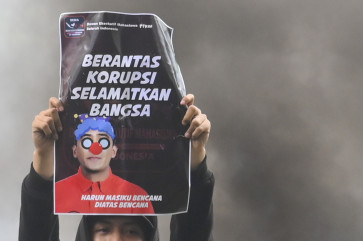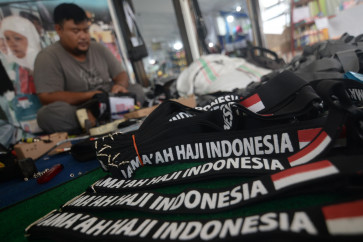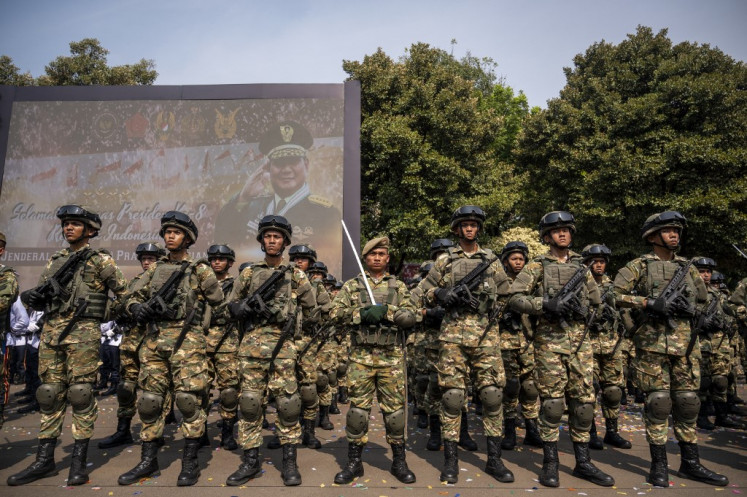'Restitution of 1755': Showcasing the return of feudalism to Yogyakarta
Historical intervention: Dancers perform as Dutch artist Eva Olthof reads the Dutch version of the Giyanti Agreement during the Restitution of 1755 performance in Yogyakarta
Change text size
Gift Premium Articles
to Anyone
 Historical intervention: Dancers perform as Dutch artist Eva Olthof reads the Dutch version of the Giyanti Agreement during the Restitution of 1755 performance in Yogyakarta.(JP/Bambang M)" border="0" height="341" width="512">Historical intervention: Dancers perform as Dutch artist Eva Olthof reads the Dutch version of the Giyanti Agreement during the Restitution of 1755 performance in Yogyakarta.(JP/Bambang M)
Historical intervention: Dancers perform as Dutch artist Eva Olthof reads the Dutch version of the Giyanti Agreement during the Restitution of 1755 performance in Yogyakarta.(JP/Bambang M)" border="0" height="341" width="512">Historical intervention: Dancers perform as Dutch artist Eva Olthof reads the Dutch version of the Giyanti Agreement during the Restitution of 1755 performance in Yogyakarta.(JP/Bambang M)It was drizzling in Jantiharjo village, Karanganyar regency, Central Java, when Panca Rahmadi stood under a large banyan tree believed to be the place where the Giyanti Agreement was signed in 1755.
The boy, a blind 9-year-old, was singing a pangkur (classical poem) as a brief version of the accord that marked the founding of the Yogyakarta Sultanate. At the final part, he rendered two verses serving as an addendum, with the message that the ruler should avoid oppression for the peaceful life of his subjects.
Pancaâs song is the highlight of an art performance entitled Restitution of 1755, staged as part of the Hacking Conflict, the theme of Biennale Jogja XIII-Equator #3 Indonesia Meets Nigeria. Three artists â Irwan Ahmett, Tita Salina and Yudi Ahmad Tajudin â created the show to mark the Giyanti Agreement, which was signed 260 years ago, which has been a source of agrarian conflict in Yogyakarta ever since.
âWeâve always intervened in public places, reminding people of certain issues,â Tita explained.
Every afternoon, Panca also sings apangkur written by ancient manuscript expert Rendra Agusta at the Jogja National Museum, which hosts the biennale from Nov. 1 to Dec. 10.
âI designed the performance after observing an imaginary line in Yogyakarta linking the southern sea with Mount Merapi, only to find many hotels from the Yogyakarta Palace to the Tugu Pal Putih monument,â Irwan said.
Yogyakarta has changed, and I think something is wrong, as thereâs economic disparity. My research shows that the root cause is the Giyanti Agreement.â
The treaty was a solution offered by Dutch Governor General Nicolaas Hartingh to end the conflict between then-Mataram king of Surakarta Pakubuwono III and his brother Prince Mangkubumi.
In the agreement, Mangkubumi received the title Sri Sultan Hamengkubuwono I and was named king of keraton Yogyakarta. The palace was given land with Dutch borrowing status, but the king was granted the right to hand it down. Now, part of the land is within Yogyakarta province.
Since the Yogyakarta Special Region Law took effect, Yogyakarta sultan Governor Hamengkubuwono has instructed the provincial government to make an inventory of land without ownership basis and other land specified in the law to become the property of Keraton Yogyakarta and Pakualaman territory. âThereâs no state land in Yogyakarta,â said the governor.
The policy, which contradicts the Agrarian Law, has triggered considerable agrarian conflict in Yogyakarta. Only in Yogyakarta are citizens of Chinese descent barred from owning land.
âIf the sultan still reserves the right to use the Giyanti Agreement as a basis for acquiring the land, then community groups and I should also be entitled to give an addendum to the accord,â said Irwan.
So, Irwan produced Restitution of 1755. In the showâs prologue, he highlights the intention to make his creation an addendum to terminate the Giyanti Agreement that strengthens feudalism in Java.
âAny dissent should not be faced with force, but cool-headed discussions that prioritize the majorityâs interests rather than a small groupâs gains,â Irwan said.
span class="caption">Historical intervention: Dancers perform as Dutch artist Eva Olthof reads the Dutch version of the Giyanti Agreement during the Restitution of 1755 performance in Yogyakarta.(JP/Bambang M) It was drizzling in Jantiharjo village, Karanganyar regency, Central Java, when Panca Rahmadi stood under a large banyan tree believed to be the place where the Giyanti Agreement was signed in 1755. Yogyakarta has changed, and I think something is wrong, as there's economic disparity. My research shows that the root cause is the Giyanti Agreement.' In the agreement, Mangkubumi received the title Sri Sultan Hamengkubuwono I and was named king of keraton Yogyakarta. The palace was given land with Dutch borrowing status, but the king was granted the right to hand it down. Now, part of the land is within Yogyakarta province. Rendra, who has been conducting research on the treaty for ten years and read hundreds of Javanese manuscripts, said this agreement was born amid various wars and rebellions on Java Island. 'It has nine articles, 24 auxiliary deals and 800 sheets of stories written in Javanese characters and Dutch language,' he said. 
H
The boy, a blind 9-year-old, was singing a pangkur (classical poem) as a brief version of the accord that marked the founding of the Yogyakarta Sultanate. At the final part, he rendered two verses serving as an addendum, with the message that the ruler should avoid oppression for the peaceful life of his subjects.
Panca's song is the highlight of an art performance entitled Restitution of 1755, staged as part of the Hacking Conflict, the theme of Biennale Jogja XIII-Equator #3 Indonesia Meets Nigeria. Three artists ' Irwan Ahmett, Tita Salina and Yudi Ahmad Tajudin ' created the show to mark the Giyanti Agreement, which was signed 260 years ago, which has been a source of agrarian conflict in Yogyakarta ever since.
'We've always intervened in public places, reminding people of certain issues,' Tita explained.
Every afternoon, Panca also sings apangkur written by ancient manuscript expert Rendra Agusta at the Jogja National Museum, which hosts the biennale from Nov. 1 to Dec. 10.
'I designed the performance after observing an imaginary line in Yogyakarta linking the southern sea with Mount Merapi, only to find many hotels from the Yogyakarta Palace to the Tugu Pal Putih monument,' Irwan said.
The treaty was a solution offered by Dutch Governor General Nicolaas Hartingh to end the conflict between then-Mataram king of Surakarta Pakubuwono III and his brother Prince Mangkubumi.
Since the Yogyakarta Special Region Law took effect, Yogyakarta sultan Governor Hamengkubuwono has instructed the provincial government to make an inventory of land without ownership basis and other land specified in the law to become the property of Keraton Yogyakarta and Pakualaman territory. 'There's no state land in Yogyakarta,' said the governor.
The policy, which contradicts the Agrarian Law, has triggered considerable agrarian conflict in Yogyakarta. Only in Yogyakarta are citizens of Chinese descent barred from owning land.
'If the sultan still reserves the right to use the Giyanti Agreement as a basis for acquiring the land, then community groups and I should also be entitled to give an addendum to the accord,' said Irwan.
So, Irwan produced Restitution of 1755. In the show's prologue, he highlights the intention to make his creation an addendum to terminate the Giyanti Agreement that strengthens feudalism in Java.
'Any dissent should not be faced with force, but cool-headed discussions that prioritize the majority's interests rather than a small group's gains,' Irwan said. 
As he was reading the content of the Giyanti Agreement, five dancers emerged, three females and two males, performing a choreography based on dancer Anastasia Melati's research.
It began to drizzle, but the performance kept going. Dutch artist Eva Olthof read the agreement's Dutch version, while three of the dancers still performed.
At the end of the show, Panca sang the last two verses as the treaty's addendum. Near him, under the banyan tree, was a small flag called erucokro, carried by the troops of Prince Diponegoro from Keraton Yogyakarta, who staunchly defended common people and fought Dutch colonialism.
Irwan said Panca represented a disabled punokawan (royal servant) as found in the wayang (shadow puppet) theater to criticize the ruling power.
Will Restitution of 1755 arouse public awareness and launch a movement to end land ownership concentration? Only history will give the answer to this big question.
Your Opinion Matters
Share your experiences, suggestions, and any issues you've encountered on The Jakarta Post. We're here to listen.
Thank You
Thank you for sharing your thoughts. We appreciate your feedback.
Share options
Quickly share this news with your network—keep everyone informed with just a single click!
Gift Premium Articles
to Anyone
Share the best of The Jakarta Post with friends, family, or colleagues. As a subscriber, you can gift 3 to 5 articles each month that anyone can read—no subscription needed!
Continue in the app
Get the best experience—faster access, exclusive features, and a seamless way to stay updated.









